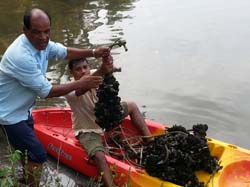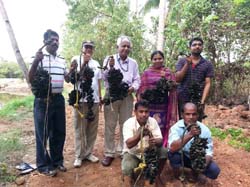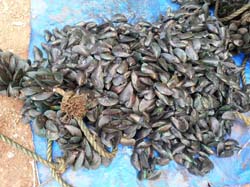 Goa has an enormous brackishwater resource potential with an area of 330 ha for augmentation of coastal mariculture. However, the lack of awareness about the relevant technology among the people was found to be the major cause of poor growth of this sector. Being a tourist destination and majority of population consuming fish, there is a high demand for finfish and shellfish in Goa.
Goa has an enormous brackishwater resource potential with an area of 330 ha for augmentation of coastal mariculture. However, the lack of awareness about the relevant technology among the people was found to be the major cause of poor growth of this sector. Being a tourist destination and majority of population consuming fish, there is a high demand for finfish and shellfish in Goa.
Green Mussel, Perna viridis, locally known as “Xinanneo” is found to be a major shell fish species under the group bivalves relished by the Goan people. A single piece of the mussel of size of 40-60 mm with an average weight of 30-33gm costs around Rs. 5 to 8 in the retail markets of Goa. This species grows well in brackish waters with a salinity ranging from
25-32 ppt. Hence, the resource augmentation through farming techniques in the unutilised brackish water areas of Goa can only meet the required demand for the same in future. Mussel farming using various techniques like Rack, Raft and longline are robust ecofriendly methods and there are no extraneous inputs like feed, fertiliser and other materials to the culture system. Thus, the maintenance of the culture system is also comparatively easy. Usually the culture period starts from November or December after the adequate spat (seed) settlement along the coastal areas and subtidal beds. It will extend up to May with a period of about 6-7 months. However, harvest will be done before June since the monsoon will retard the salinity and affect the mussels.
Highlighting this background, ICAR Research Complex for Goa initiated demonstration on rack culture of P. viridis in a semi- enclosed water body of 0.6 ha integrated with piggery unit of Antonio Bosco Menezes at Goavelha during November last year. Sixty muslin bags each filled with 1 kg mussel spat (with an average size with 28 mm length and 2 g weight) was used for stocking in the rack structure. Regular monitoring and advisories were provided and biweekly analysis of the physicochemical and biological parameters of water, sediment and mussel was carried out. The harvest was carried out after a period of six months. The farmer was able to get a production of 5760 mussels with a total weight of 186.125 kg from 60 kg mussel spat. Each mussel was sold at a price of Rs.5/piece with an average weight of 33g. Total production cost was around Rs. 14,370. The total returns and the net profit gained were Rs. 28,800 and Rs. 16,510 respectively.



After the successful demonstration of the current trail, about fifteen farmers have shown interest to take up the mussel culture in estuarine and coastal waters in Goa in the next season after monsoon. Thus, the successful demonstration of mussel culture has built a new path for the development of coastal mariculture in Goa.
(Source: ICAR Research Complex for Goa)








Like on Facebook
Subscribe on Youtube
Follow on X X
Like on instagram